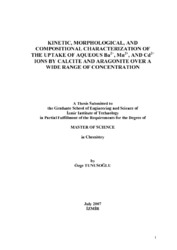Please use this identifier to cite or link to this item:
https://hdl.handle.net/11147/3823Full metadata record
| DC Field | Value | Language |
|---|---|---|
| dc.contributor.advisor | Shahwan, Talal | - |
| dc.contributor.author | Tunusoğlu, Özge | - |
| dc.date.accessioned | 2014-07-22T13:52:26Z | - |
| dc.date.available | 2014-07-22T13:52:26Z | - |
| dc.date.issued | 2007 | - |
| dc.identifier.uri | http://hdl.handle.net/11147/3823 | - |
| dc.description | Thesis (Master)-- İzmir Institute of Technology, Chemistry, İzmir, 2007 | en_US |
| dc.description | Includes bibliographical references (leaves: 71-78) | en_US |
| dc.description | Text in English; Abstract: Turkish and English | en_US |
| dc.description | xiii, 78 leaves | en_US |
| dc.description.abstract | The large availability and widespread distribution of calcium carbonate, CaCO3, in Earth.s crust makes it among the most important minerals to investigate in terms of environmentally and geochemically important aqueous-metal partitioning interactions. In this study, the interactions of Ba2+, Mn2+, and Cd2+ with calcite and aragonite were investigated over a wide range of experimental conditions. The experiments were conducted to examine the effects of time, concentration, pH, temperature on the uptake process assess at low concentrations and the composition and morphology of the precipitated carbonates. The kinetic data corresponding to adsorption were adequately described by the pseudo-second order rate equation. At equilibrium, the extent of adsorption on both minerals followed the order Cd2+ > Mn2+ > Ba2+. Precipitation of metal carbonates proceeded at a slower rate and led to large removal of the ions under consideration. The mass fractions of the precipitated metal carbonates were determined using quantitative XRD. For this purpose, empirical equations were developed for binary carbonate mixtures. FTIR was used to follow the possible modifications in vibrational modes of calcite and aragonite, and the newly emerging vibrations of various carbonate phases. According to SEM results, BaCO3 crystals appeared to be 1-2 micrometers in size with an olivary-like shape and MnCO3 crystals assumed a cubic shape with 200-400 nm size. The particles of precipitated CdCO3 did not demonstrate a well defined shape and its texture appeared to be composed of aggregated sub-micron crystals that form micron sized particles with irregular appearance. | en_US |
| dc.language.iso | en | en_US |
| dc.publisher | Izmir Institute of Technology | en_US |
| dc.rights | info:eu-repo/semantics/openAccess | en_US |
| dc.subject.lcc | TP245.C3 T92 2007 | en |
| dc.subject.lcsh | Calsium carbonate | en |
| dc.subject.lcsh | Metal ions | en |
| dc.subject.lcsh | Heavy metal--Analysis | en |
| dc.subject.lcsh | Morphology | en |
| dc.subject.lcsh | Fourier transform infrared spectroscopy | en |
| dc.title | Kinetic Morphological, and Compositional Characterization of the Uptake of Aqueous Ba2+, Mn2+, and Cd2+ Ions by Calcite and Aragonite Over a Wide Range of Concentration | en_US |
| dc.type | Master Thesis | en_US |
| dc.institutionauthor | Tunusoğlu, Özge | - |
| dc.department | Thesis (Master)--İzmir Institute of Technology, Chemistry | en_US |
| dc.relation.publicationcategory | Tez | en_US |
| dc.identifier.wosquality | N/A | - |
| dc.identifier.scopusquality | N/A | - |
| item.openairecristype | http://purl.org/coar/resource_type/c_18cf | - |
| item.languageiso639-1 | en | - |
| item.openairetype | Master Thesis | - |
| item.grantfulltext | open | - |
| item.fulltext | With Fulltext | - |
| item.cerifentitytype | Publications | - |
| Appears in Collections: | Master Degree / Yüksek Lisans Tezleri | |
Files in This Item:
| File | Description | Size | Format | |
|---|---|---|---|---|
| T000657.pdf | MasterThesis | 4.78 MB | Adobe PDF |  View/Open |
CORE Recommender
Page view(s)
236
checked on Mar 31, 2025
Download(s)
96
checked on Mar 31, 2025
Google ScholarTM
Check
Items in GCRIS Repository are protected by copyright, with all rights reserved, unless otherwise indicated.